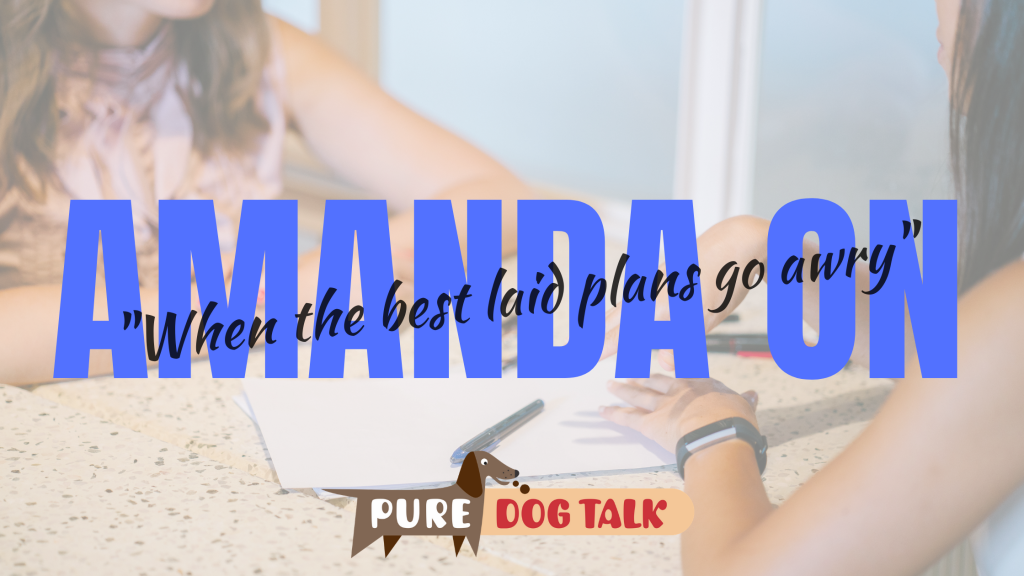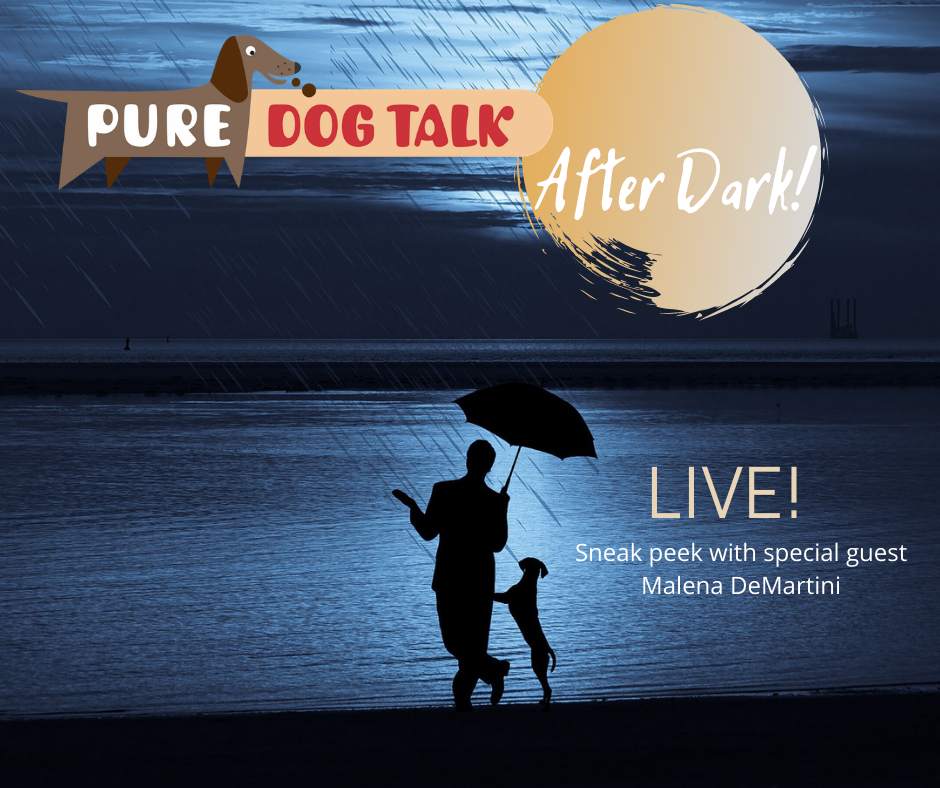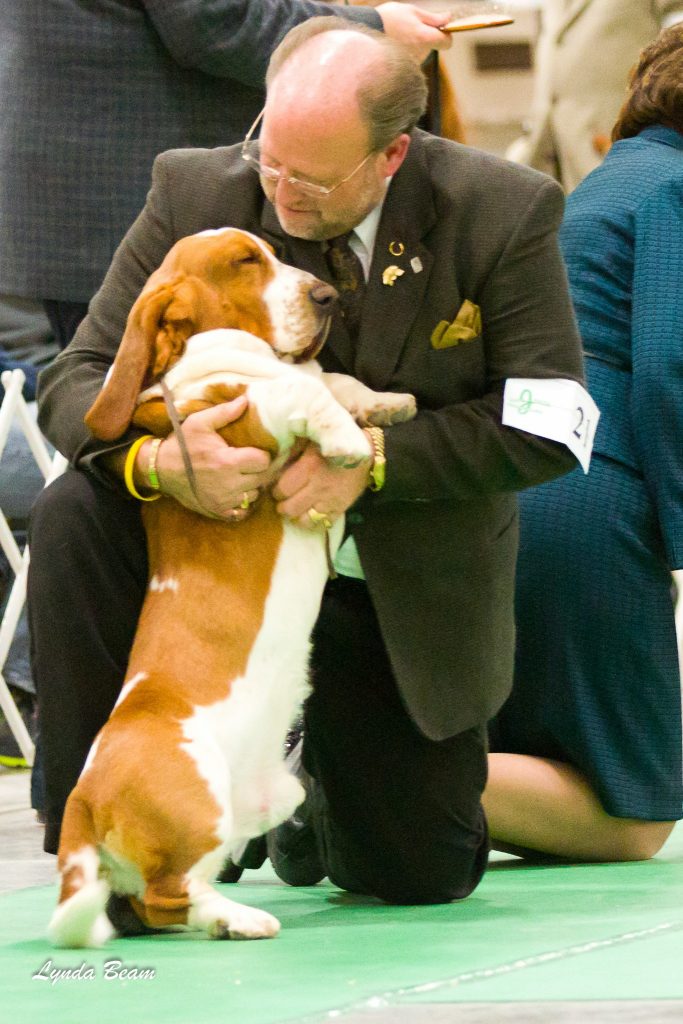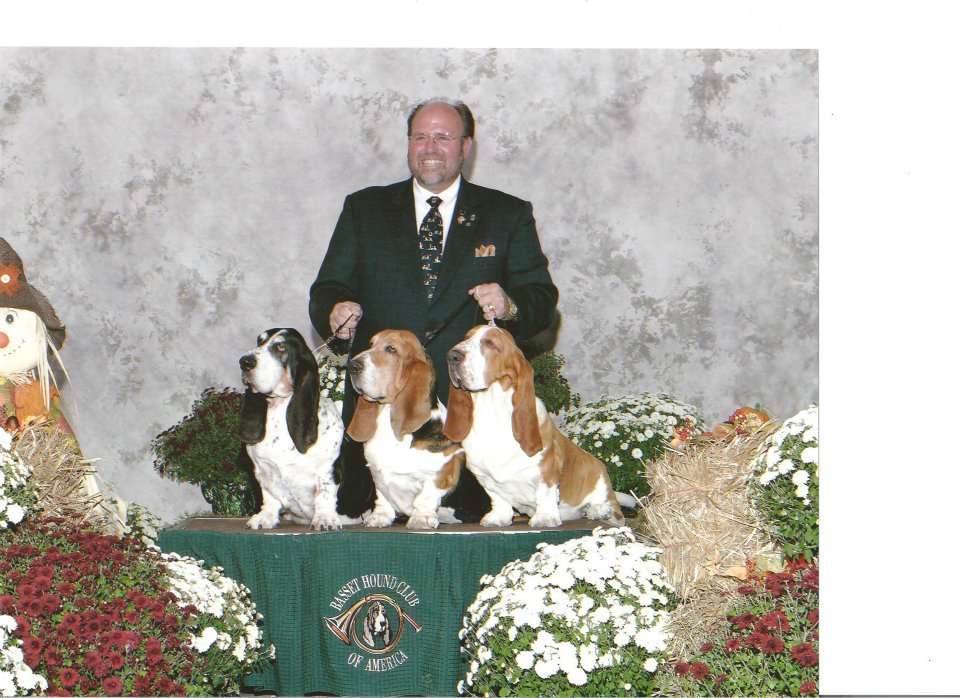485 — Korean Jindo: Independent, reserved, polite and serious
Korean Jindo: Independent, reserved, polite and serious
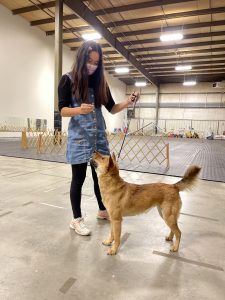
Hannah Yi and her Jindo practicing for Junior Showmanship competition.
Hannah Yi and Nichole Royer join host Laura Reeves to share information about the rare and fascinating Korean Jindo.
Developed on Jindo Island, off South Korea’s coast, as an isolated population of centuries old village dogs, the breed is a cultural icon in its home country. Renowned for its ability to find its way home, a feature memorialized in Korean culture, Jindo are dedicated hunting dogs and very serious about guarding their home.

Jindo in South Korea.
“They were developed as a pretty hardcore hunting and guard dog,” Royer noted. “They are generally used for hunting small game, but they also hunt deer and even wild boar in small groups. They are not a breed that developed hunting along with their owners. They actually expected Jindos to go out and catch small game on their own and bring it home.
“When they chased down something like a deer, and I should add the deer and the wild boar on Jindo island are not the size of the deer and wild boar we have here in the US. The deer are much smaller … a small group of Jindos would chase them down and then a couple of the Jindos would stay there to guard the deer, while one or two dogs went to find the owner.
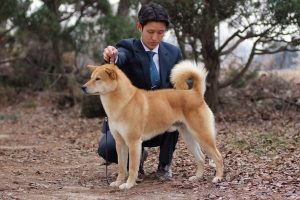
Jindo in South Korea
“(They were) designed to go out, be able to think for themselves, be able to make their own decisions. They take their owner’s wishes under advisement, but really are not designed to go around saying ‘what can I do for you.’ It’s a partnership rather than being what the dog can do for their owner.”
“I visited Korea a couple of times as a child,” Yi said, “and in the neighborhood and a bit of the rural parts, you would see them outside … I always (had them) pointed them out ‘hey, that’s a Jindo dog.’ They’ve always been a really independent spirit. Even though I didn’t know much about them as a kid, I just knew that (they were) culturally ingrained in your knowledge.
“(The story in Korea is) there was this dog and it was a white Jindo dog … it lived with its elderly owner in the city. But one day the owner had to sell the dog. So it was really far away. Then seven months later, the dog appeared back to the owner’s house. It found its way home. So that’s just really stuck to a lot of people. There are a lot of children’s books and merch made about that and it was just really interesting to me. I’ve just always known that story.”
While Dog Aggression is a serious awareness with the breed, Royer notes, “They are intelligent guard dogs that are not looking for that excuse. They will act if they have to, but they’re not looking to want to act.
“Same sex dog aggression is absolutely the norm in this breed. This breed in public should not be aggressive towards other dogs without good reason. However a strange dog getting in their personal space absolutely is good reason. They do not tolerate fools lightly and they do not tolerate rude behavior from other dogs. Jindos never pulled their punches. If they choose to use their teeth, they intend to do damage.
“Jindos tend to be a one person or one family dog. They should never be aggressive without good reason. But they also generally are not going to be like my malamutes who will jump into everybody’s lap and everybody is their new best friend. They range from being very reserved ‘I don’t know you, so I don’t really want you touching me’ to being calmly friendly. Very polite.”
484 – Five Ps in Passport to Successful Reproduction
Five Ps in Passport to Successful Reproduction
Dr. Marty Greer, DVM, joins host Laura Reeves to discuss the five Ps in the passport to successful dog breeding.
Progesterone
“We need to start progesterone testing early enough and repeating the testing often enough and long enough to make sure that she’s ovulate plus one test beyond that. So ovulation in most people’s labs is going to be between four and eight nanograms per mil.
“Be sure you start early enough and you go long enough that you’ve got one progesterone past five. If you stop at 4.7 and then she doesn’t get pregnant, we don’t know if she actually did or not (ovulate)… It’s not only to get the breeding done successfully, it’s also so that you can time when she’s doing to whelp.
“I cannot overemphasize the importance of progesterone timing. If nothing else, you’re going to have the vet clinic on your side when you call, (instead of) saying, ‘Well, really I have no idea when she’s actually due.’ I don’t know if you’re overstating the crisis that you’re in, if you’re underestimating the crisis you’re in, but without that data we really, as a veterinary community, don’t have the information we need to start initiating early care to save your bitch to save your litter.
Prenatal Care
“We know from the human side how important good prenatal care is. There’s a reason that women that are pregnant go to the doctor frequently. We need to monitor the bitch during prenatal care but even before she gets pregnant, we need to start folic acid 6 to 8 weeks before she comes into heat. We need to have her in an ideal body condition. We need to make sure she’s on an appropriate diet that doesn’t contain legumes, peas and beans. And we need to make sure she’s on a diet that’s got the macro and micro nutrients that she’s going to need to be pregnant and sustain a pregnancy.
“We want to make sure vaccines are up to date, because you can’t vaccinate during pregnancy and if she comes due during the time she’s pregnant, we cannot vaccinate. We want to make sure she’s an appropriate heartworm and flea and tick preventives that are safe for breeding dogs.
“We want to make sure that we’ve brucellosis tested her well enough in advance that if she comes back positive we can do the confirmatory test, because up to 10% of the brucellosis test will come back positive, and that can be a false positive. Now, that being said, it’s easy to say ‘Oh yeah, brucellosis doesn’t happen in the United states anymore.’ And guess what that’s not true.
Puppy Count X-ray
“Take the X-ray somewhere between day 55 and a 60 of her pregnancy.
“People say, ‘oh I’m not going to do that… it’s not safe or it’s not accurate…’ I’m going to give you some tips that can make it accurate. If you are taking X rays with a digital machine … it’s very safe. The exposure to X-rays is very, very low. In fact if you live in Denver, where the altitude is high, you have the equivalent from sun exposure and radiation of five to 10 chest X-rays a year, just living in that environment.
“Go to a vet that has a digital X-ray machine. Take your bitch fasting. She needs to not have breakfast the morning you take her in for the X-ray. (Make sure she has a bowel movement) before you go in, so her hair colon is empty because the more food and the more stool in the colon the harder it is for us to see the puppies on the X-ray.
“We take two lateral X-rays, meaning that they lay on their side. We put them on the right side down and we put them on the left side down. I don’t care what order you do it in, but I don’t take them on their back. What’s really cool about it is, many times you’ll see seven puppies on first X-ray and you roll them over and an eighth puppy appears. (Most likely) they were perfectly aligned in the uterus and you missed one but that roll, that repositioning of the uterus by putting her on the opposite side, will illustrate another puppy.
Preparing for Whelping
| Supply and Equipment List:
• Whelping box • Puppy Scale • Rectal thermometer • Room thermometer • Vaseline • Notebook • Cotton balls • Method to identify puppies – fingernail polish or fabric paint • Heat source • Graph paper • Exam Gloves • Starter mousse • Soap • Whelping pads • Towels • Ice cream • Brats • Oatmeal • Puppy or kitten formula • Feeding tubes and syringes • Feeding bottles • Electrolytes • Car with a full tank of gas • Cell phone and charger • Ice chest or other transport device with heat for taking puppies to and from the vet • Lubricant – non petroleum • Hemostat • Dental floss to tie off cords • Gauze • Scissors • Tincture of iodine • Chlorhexidine disinfectant and shampoo • Vanilla ice cream • Cotton balls • Tarps or flannel backed tablecloths to cover the floor |
Drug and medical equipment list:
• Fenbendazole • Frozen Plasma • 5 Hour Energy • Dopram • Vitamin K • Oral Cal plus calcium gel • Nuture-mate • Probiotics • Forti-cal • Delee mucus trip • Bulb syringe • Feeding tube syringe and formula • 25 g needles • Oxy momma • Adaptil or ThunderEase Pheromone collar • Glucometer and strips • Oxygen concentrator • Pulse oximeter • Pyrantel pamoate • Stethoscope • Oxytocin • Fluids for SQ use • Eagle Sweetened Condensed Milk • Needles and syringes • A great friend who knows about dogs and can remain calm
|
Planning C-section
“Planning ahead can make the difference between great puppy survival and heartbreak. If you were planning to whelp (naturally) and things don’t go well, then having a plan in place can turn a bad situation around. You need to have a vet that you know you can call. You need to have an emergency clinic that you know is available. Find out before you go in what kind of anesthesia they use, if they’re going to hold your bitch hostage and only do the C-section if you let them spay her. Which is a terrible, terrible, terrible idea. I never spay at C-section because bitches lose up to 30% of their blood volume and can go into shock.”
483 — Separation Anxiety: Myth Busting with Malena DeMartini
Separation Anxiety: Myth Busting with Malena DeMartini
Malena DeMartini, canine behavior specialist focused on separation anxiety, joins host Laura Reeves for some mythbusting around anxiety, separation anxiety, genetics and heritability of anxieties and fears, and more.
“When we’re talking with regard to separation anxiety, your dog is not being a jerk,” DeMartini said. “Nor are they being spiteful. Nor are they just angry at you because you’re not spending enough time with them. All of that discussion, that is not what’s happening. What is happening is so important that we understand from a compassion and empathy standpoint, as well as from a training standpoint. These dogs are panicked. This is a true phobia to being left alone. I want to remind people that, by definition, phobias tend to be rather irrational, or at least irrational to the person that’s not experiencing that.
It really isn’t your fault
“Spoiling, and this is how they represent spoiling: letting a dog sleep on the bed, letting a dog on the furniture, giving them lots of treats or feeding them extra goodies, or taking them on car rides with us, all these sorts of activities, which in my head are part of having a family member, none of those things are either causational or correlational for separation anxiety.
“When you have a dog with separation anxiety, you are going to get every naysayer in the universe coming after you saying it is your fault … I just want people to absolve themselves from that guilt and no they did not create an animal with separation anxiety by letting him snuggle on the couch.”
Don’t “feed the beast”
DeMartini also offered recommendations on how to not “feed the beast” of a dog’s anxiety.
“When I talk about nonchalant exits and entries, we have to remember that dogs are masters of discrimination. Yes, they know when we’re leaving and so taking an extra five minutes to give them kissy sounds can just put more emphasis on the exit. So, I tell people your dog has figured out that you put on your shoes, you’ve grabbed your backpack, got your keys in your hand, your dog is fully aware that you’re about to leave, you don’t have to tell him anything.
All in the family?
DeMartini provided insight on the genetics and epigenetics of anxiety and fear in dogs, as well.
“In the last few years (researchers) have actually identified a haplotype, so sort of a genetic marker, that is specifically in accordance with separation anxiety. Here is the important aspect: just because (a dog has) that particular haplotype, where those genetic markers exist, does not mean that the behavior problem is going to occur. That’s where the epigenetics play a role. These are like toggle switches. So that toggle switch may remain off for the lifetime of that animal but there are some environmental influences that could flip that toggle switch.
“You can have the most beautiful well-bred dog physically, but if they are suffering from a welfare perspective because of their mental health that’s a problem.
Behavior modification
“Separation anxiety is actually a behavior that is quite modifiable. It’s not easy and it takes time, but we can do a lot to optimize dogs for a long-term success in the beginning of their lives. Just because there’s that genetic potential predisposition, that doesn’t mean that we can’t change it. Heritability is not a diagnosis of a permanent state.
“Separation anxiety behaviors are evolutionarily appropriate for puppies at a young age. How many of us have seen a puppy cry and the bitch comes back. We’ve seen it over millions of years of evolution that there is a purpose for vocalization and some of these other behaviors when these pups are really, really young. But the majority of them do grow out of it. If they don’t it’s become sort of maladaptive. When it becomes maladaptive in a 14 or 16 or 18 week pup, no amount of letting them cry it out and try and get over it is going to help them grow out of it. That is a moment in time where we say, ‘we’ve got to give this pup some training and give them that metaphorical soft place to land in order to help them through this.”
482 – Nutrition in Breeding Dogs with Dr. Gayle Watkins
Nutrition in Breeding Dogs with Dr. Gayle Watkins
Dr. Gayle Watkins, founder of Avidog and Head of Education at Good Dog, joins host Laura Reeves for a fascinating and informative conversation on the nutrition requirements for breeding dogs.
Watkins addresses raw feeding, kibble and specific nutrient requirements, especially calcium:phosphorus percentages, that enable the animals in our breeding programs to be successful in conceiving and raising their litters.
“We don’t have a lot of really good research on optimizing nutrition for breeding animals, either stud dogs or bitches, and we have a lot of myths,” Watkins said.
“If you are in the US, you need to feed an all-life stages or growth and reproduction diet to your breeding dogs. Ideally, that is also for stud dogs, but we don’t have much information on that. Definitely your bitches, as they prepare to breed, while they’re being bred, during pregnancy and during lactation. Adult maintenance food is inadequate for reproduction. It is not designed for reproduction.
“Dogs are scavengers … think about the stuff they eat! But breeding animals, we’re asking those bitches to do so much. They not only have to create puppies, they have to maintain their own body while that’s happening and they have to maintain their brain. So I think we have an obligation to not do homemade foods with our breeding bitches.
“I’m a big fan, if we can find those foods that are also certified by AAFCO through feeding trials. The all life stages feeding trial covers just prior to being bred, pregnancy and it covers their puppies for 10 weeks. So it’s a big feeding trial and that food has been tested as much as it could possibly be tested.”
Watkins continues with specific recommendations on additional micronutrients, fatty acids, probiotics and other supplements.
For previous Pure Dog Talk episodes on breeding topics with Dr. Watkins, click here, here, here and here.
481 – When the Best Laid Plans Go Awry
When the Best Laid Plans Go Awry
Amanda Kelly, Fwaggle Toy Manchester Terriers, joins host Laura Reeves for a conversation about dog breeding when you plan ahead, do your research and then the results don’t match the expectations.
Amanda and Laura swap stories about all of the times a breeding looked great on paper and was a disaster on the ground in one way or another. The takeaway? Breeding dogs will keep you perpetually humble and learning.
Unexpected markings. Dual sired litter rabbit holes. Repeat breeding pros and cons. And permission to fail.
A sense of humor helps keep it all in perspective. Keeping temperament and health as top priorities in a breeding program means that even if the pups in a litter don’t meet your expectations for the show ring, they will still live long, healthy lives as beloved companions.
“What I love about (dog breeding) is that there’s not clear answers,” Amanda noted. “We can ponder the theories and the different ideas and we can try new things if we give herself permission to do it. I hope when breeders have been around for a long time and are helping others that, I hope, is the gift that they’re giving them. Permission to try things, to try something new and different. What’s the worst thing that happens? They had some pets. The pet people are pretty happy about that.
“There’s not a right or wrong way to do this. If I’ve learned anything from doing this for many years and watching different breeders, there are 1000 different ways to do this. None of them are right or wrong, as long as we have the welfare of our dogs at heart. And we will learn something new every time.
“Every breeding that you do has value. You said it earlier, you learn something. You learn about what not to do, you learn about how your line is producing. So when that best in show dog winds up neutered because you made a bad choice in your puppy evaluation, you have to let it go.
“You need to be able to make a decision and live with it in the planning of a breeding and the evaluation of puppies. So allowing yourself to fail without feeling like a failure is the greatest freedom that you will give yourself as a breeder. I think sometimes we just get so wrapped up in the breeding that’s in front of us that we won’t allow ourselves to fail, we won’t allow ourselves to say ‘you know what, there’s nothing in here that I want to keep and so I’m going to let them go (to pet homes).”
480 – Which Comes First: Show Ring or Whelping Box?
Which Comes First: Show Ring or Whelping Box?
Dr. Marty Greer, DVM, joins host Laura Reeves for a discussion about whether we should show or breed our dogs first. Our consensus? Breed them, *then* show them.
“The whole reason that we show our dogs in AKC,” Greer said, “and the whole reason that AKC makes us show dogs that are intact, is because they are meant to be reproducing.
“I really think we need put a bitch’s breeding career way up the list of priorities. It is difficult when you’ve got a bitch, or a male for that matter, out there winning. It’s hard to pull them. It’s hard to miss that opportunity. But I look at it as most bitches, most dogs, get better with age. They look better when they get to being mature at five, six years old. But fertility isn’t so kind. Fertility is an elusive and a God given right. If we don’t take advantage of the youth and the fertility associated with youth, I think we’re missing a big opportunity.”
Better living through chemistry
Greer runs through the pros and cons of using drugs to inhibit heat cycles in bitches, including including Cheque drops and Ovaban. She also covers medication that can be used to bring bitches into season as well as nutritional considerations that may need to be addressed first.
Greer’s advice for breeders on how to transition a nursing bitch successfully into a show career following a litter includes exercise and Witch Hazel.
Discussing the importance of collecting males for frozen semen while they are young, Greer again offers this advice.
“I have people that come in all the time with older dogs. They may be sick. They may be elderly. And they’re just like I really, really, really wanna puppy out of this guy. I really need semen… and they’ve got three sperm and two of them are swimming backwards and there’s nothing we can do with that. Nothing you can do. We have a sign on our wall in big letters that says ‘Freeze early and freeze often.’”
479 – Anxiety, FOMO or Frustration?
478 — Bryan Martin: Read Your Standard and Dream BIS Line up
Bryan Martin: Read Your Standard and Dream BIS Line up
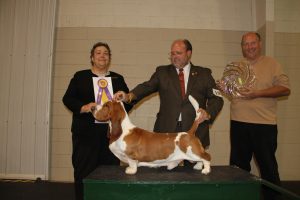 Bryan Martin, retired professional handler, former AKC executive field representative and newly minted Hound group judge joins host Laura Reeves for part two of his amazing stories and advice for exhibitors.
Bryan Martin, retired professional handler, former AKC executive field representative and newly minted Hound group judge joins host Laura Reeves for part two of his amazing stories and advice for exhibitors.
“My family would have dinner (and) during dessert, the book of standards came on the table. We had weekly discussions. ‘OK let’s talk about heads tonight.’ We’d go round the table and everyone would say something and ‘OK who do you think has a good head? Who do you think has a bad head? Do you have a picture? Go get a picture.’ One night we’d talk about shoulders and why the shoulder needs to be a wrap-around, why the shoulder needs to be well laid back, why the shoulder blade and the upper arm have to be the same length, to make it a proper working hound, how the back end has to match the front end… How the pieces fit. It’s form and function, which has stuck with me forever, and that’s my basis is form and function judging.
“It’s amazing how many people in AKC, UKC … have no understanding how to read a standard. How to interpret a standard and how to go to somebody and talk to somebody about the standard. The how’s why’s and wherefores of studying standards. At the International show where we had to write a critique, we had to know the standards. What I ended up doing was showing people what the standard says about their dog. And they say ‘oh, I didn’t know that’ and it’s a whole educational program that is missed.”
In the “Dream Best In Show Lineup” game, Martin’s choices were:
Sporting – English Springer Spaniel, Ch Salilyn’s Aristocrat
Hound – Afghan Hound, Ch Triumph Of Grandeur
Working – Doberman Pinscher, Ch. Brunswig’s Cryptonite
Terrier – Scottish Terrier, Ch. Braeburn’s Close Encounter
Toy – Japanese Chin, GCh. Pem We-Syng Lucky MI
Non-Sporting – Dalmatian, Ch. Spotlight’s Spectacular
Herding – German Shepherd Dog, GCh. Altana’s Mystique
Finally, Best in Show in this mythical lineup??
Shannon, the Scottish Terrier, shown by George Ward.
Listen above to hear all of this and more.
477 — Bryan Martin: “Basset Boy,” the Early Years
Bryan Martin: “Basset Boy,” the Early Years
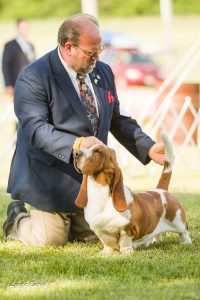 Bryan Martin, retired professional handler, former AKC executive field representative and new judge of the hound group joins host Laura Reeves for part one of a wide ranging, fascinating conversation.
Bryan Martin, retired professional handler, former AKC executive field representative and new judge of the hound group joins host Laura Reeves for part one of a wide ranging, fascinating conversation.
World famous for his work with Basset Hounds, Martin shares his early history growing up in the sport with his family and early mentors.
“I was six years old in 1960 when we went to a fun match for the Fort Dearborn Basset Hound club,” Martin said. His mother had saved up her grocery money to purchase a Basset Hound bitch who was bred to a local stud dog. They brought the puppies to the match and didn’t win anything. A club member after watching the family, approached his father with an offer he couldn’t resist.
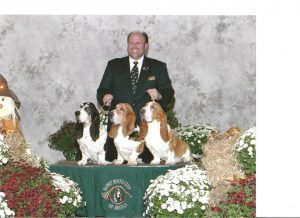
“My Three Sons” taken at the 2006 BHCA Nationals. The ONLY time the top three, all-time Best in Show winning Basset Hounds competed at the same show! L-R Ch Deerhill’s Great Gatsby, 52 all-breed bests, Ch Topsfield Bumper Cars, 45 all-breed bests and Ch Topsfield Beethoven, 34 all-breed bests, 131 in total! — Bryan Martin
“She said, ‘You know, your puppies, they’re not good. If you like to do this, I suggest you just sell the whole lot and come out to my kennel and I’ll take care of you.’ So, we did. We went out to this kennel and she said, ‘I think this is a good bitch for you. This will be a good foundation bitch for you and I’ll give you a buddy for her and the kids can work on that one.’
“We bred a litter about every year and so I got to show all the class dogs. My brother, Peter, was the Prince and he always got the specials dogs. He didn’t mess with the class dogs. But that was to my advantage, because I got to learn that you never show two dogs the same way. Like people, they all have a different personality and they all respond differently to what you do and so you work on adjustments.
“The living room (in our house) was big enough that we could move all the furniture to the side and put the couch in the middle and we had a dog show ring. We would practice dog shows. My father would either sit in the corner or on the couch in the middle. We put a mirror on the floor against the couch and we’d learn to set up our dogs in front of the mirror, to see what the judge was seeing. So if you had to poke him in the top line or to hold the tail different or whatever you could see it and that was my learning on how to show the breed.”
From secretary for horse shows just out of college to marrying Nancy, through showing record-breaking dogs for Claudia Orlandi, Martin’s journey through the sport of dogs and his nuggets of knowledge are priceless.
Listen to part one here and join us next week for part two.





